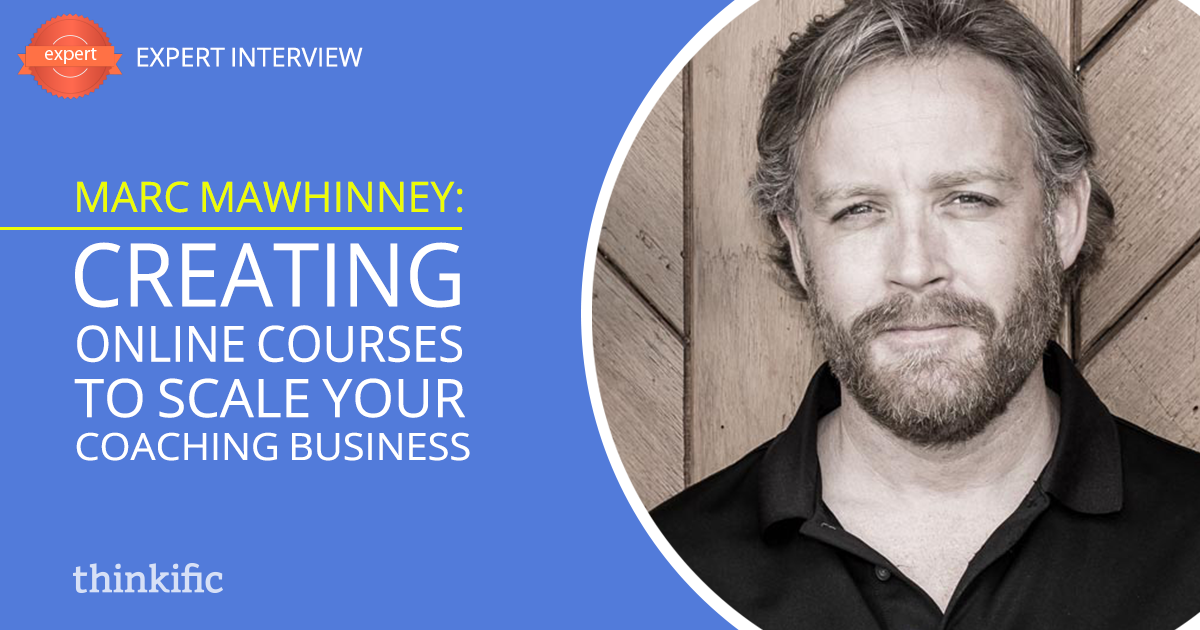If you’ve ever attended a webinar or taken a free online course, you might’ve noticed that you usually had to enter your name and email address (and possibly other information) before getting access.
Video-based resources that are housed behind lead capture forms are called gated video content — and they’re effective at helping businesses get new customers.
In this guide, we explore:
- What is gated video content?
- Benefits of gated video content
- Types of gated video content
- Gated video content strategy
- Best practices for gated videos
- Gated video platforms
- Measuring the success of your gated video strategy
- Transform your business with gated video content
- FAQ
What is gated video content?
Gated video content refers to free video material that people can access after they submit their contact information, such as their name and email address, through a lead capture form. Depending on the nature of the video content and the product(s) the business offers, the lead capture form may ask for more than just a name and email address. It may also ask for the user’s job title, organization size, and industry.
The main objective of gating video content is lead generation. Hiding high-quality content behind a lead capture form ensures that only interested people provide their details. When they do, they’re automatically added to your email list where you can directly communicate with and nurture them to become paying customers through your email campaigns.
When people submit their contact information, you get access to valuable user data, which allows you to personalize your interactions with them. When your email subscribers feel that your content is tailored specifically for them, they’ll be more inclined to open your emails and engage with your brand.
Benefits of gated video content
Gating video content is one of the best strategies a business can employ to increase its customer base. Here are some reasons why:
Lead generation
The difference between gated content and ungated content, such as blog posts, is that the latter is freely accessible. While ungated content can bring in a ton of website traffic for your brand, there’s no way to know if those visitors are interested in your product(s) or not.
Gated video content, on the other hand, is hidden behind a form. Most people don’t like having full email inboxes, so if anyone gives you their email address to get access to your content, that’s a good signal that they’re interested in your brand. These people are more likely to be receptive to your marketing efforts than visitors who merely stumbled onto your website.
Audience segmentation and content personalization
Gating your video content allows you to segment your audience and create marketing assets with them in mind. Through your lead capture form, you can collect user information like their name, email address, demographic, position, organization size, and industry, which gives you insights into your audience’s interests and preferences.
You can use this information to create buyer personas for each subset of customers. This gets rid of the guesswork; you’ll know exactly who you’re targeting, which helps you create content that addresses their needs, solves their problems, and makes their lives easier.
Increased perceived value
Website visitors often place more value on gated video content because they’re providing their contact information to get access to it.
Unlike ungated content that is consumed and forgotten about, gated content triggers the users’ curiosity gap — the space between what they know and what they want to know. And since gated content is often a “premium” extension of ungated content, interested users sign up to fill that gap.
Between one’s longing to satisfy their curiosity, the feeling of having access to exclusive content, and other special perks you offer your email subscribers, gated content can be a great way to enhance your brand’s image. When executed well, it can help you gain more high-quality leads, build trust with your prospects, and position you as an expert in your industry.
There’s a caveat, though. If people are giving you their contact information, they expect high-quality content in return. So if your gated video content isn’t packed with valuable information, you risk alienating your audience and ruining your brand reputation.
Data collection and analytics
Gated videos offer you a structured way to collect data on viewer behavior. Metrics like engagement duration, click-through rates, and completion rates help you figure out the kinds of videos that resonate with your audience. With this data, you can optimize your content and marketing campaigns to yield better results.
Improved content ROI
Gated videos can help you get a higher return on investment (ROI) for content production and marketing. Since the videos are hidden behind a form, you have a straightforward way to measure how impactful they are, including the number of leads they generate and how those leads progress through the sales funnel.
Types of Gated Video Content
Gated video content comes in many formats. Some of them include:
Webinars
Webinars are live events or pre-recorded video presentations that educate viewers on a specific topic and allow you to establish your business as an authority in your industry.
With webinars, you can feature other experts in your field, teach people how to achieve their goals in real-time, interact with your audience, promote your products, and collect high-quality leads. These events often have limited slots available, which creates a sense of FOMO (fear of missing out) that motivates people to sign up.
Read more: Webinars 101 – How to Create a Webinar
For example, Hotjar is hosting a live virtual event where web strategy experts teach attendees how to create a high-converting website with Hotjar and HubSpot.

On the landing page, Hotjar explained the importance of the topic and what people will learn from the webinar if they attend it. Then they embedded a lead capture form where people can provide some information about themselves in exchange for a Zoom link invite delivered straight to their inbox.
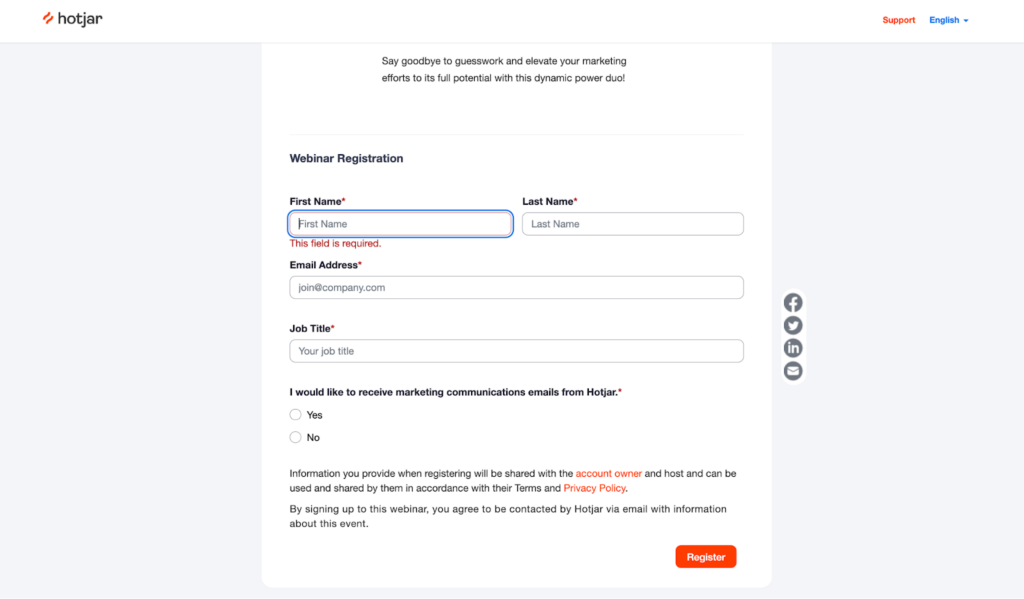
Online courses
Because online courses provide in-depth training on a particular subject or skill set, you can use them to position your brand as an industry expert. They also serve as a means to capture leads who are interested in knowing more about your industry/business, whom you can later nurture to become paying customers.
To get the most out of online courses, choose an industry-related skill/topic that aligns with your broader marketing strategy and create a series of detailed videos explaining that topic. Not only can this attract new leads, but it can also nudge people who are familiar with your brand further down the sales funnel.
For example, Semrush, the SEO company, partners with industry experts to create marketing-based courses, like this one by Brian Dean.
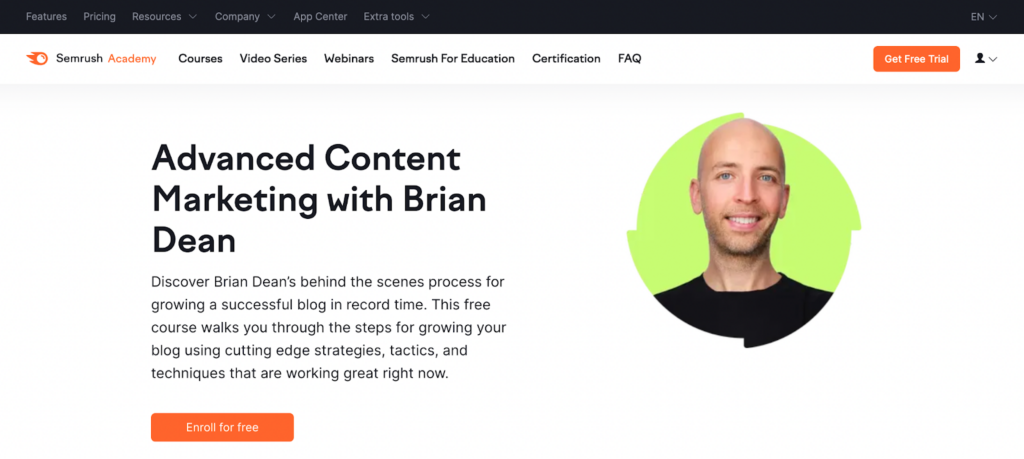
The landing page breaks down the target audience for the course, what they’ll learn, and the course structure. It ends with a form interested users must fill out to gain access to the free course.
Exclusive interviews
Just like webinars, exclusive interviews feature productive conversations with industry experts, thought leaders, or key stakeholders. Not only do these conversations help you build your brand authority, but they also increase brand awareness by attracting the audience of the expert(s) you’re interviewing.
If you want to create thought leadership content for your brand, conducting exclusive interviews is a great route to take because you’ll get first-hand experiences, analogies, and case studies that can’t be found anywhere else. What’s more, you can boost audience engagement by getting your interviewees to answer your viewers’ most pressing questions. This encourages people to sign up, watch the videos, and send in questions.
Pro tip: Some companies like Omniscient Digital interview subject matter experts, and upload the audio version on their podcast and the video interview on the website and YouTube channel. This is an effective way to repurpose your interviews.

Product demos
Product demos (or demonstrations) showcase how a product or service works, highlighting its features, functionality, and the benefits users will enjoy if they purchase the product/service. The main objective of product demos is to convince prospects who are on the fence that your product can address their needs and solve their problems better than your competitors’.
Gating your product demos allows you to gather leads from people at the bottom of the funnel who are actively interested in your product. For example, Demio, a company that offers webinar software for marketers, gives interested prospects the option of booking a product demo.
By gating its demo, Demio only gets high-quality leads that are willing to sit on a 1-on-1 meeting with a Demio expert.
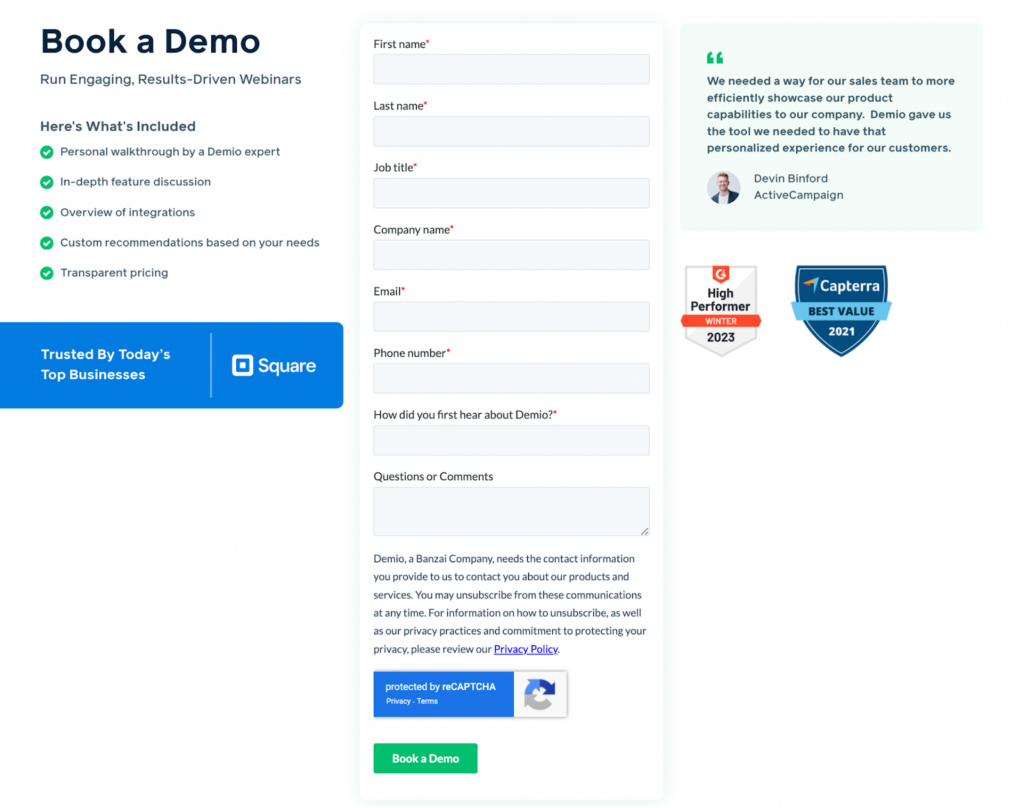
Case studies and success stories
While most companies make their case studies freely accessible, gating some of them can be a great way to collect leads that are interested in specific use cases.
The rationale behind this is that case studies are a highly persuasive type of content because they showcase real-world examples of how your products/services have benefited existing/past customers. They answer the question that every prospect has before making a purchase: “Will this product deliver on its promise?”
Gating your case studies can work really well at filtering out your leads, especially if your product/service caters to a specific kind of audience.
Gated video content strategy
If you’re planning to gate your video content, here are some steps to take to ensure that you get the most out of this marketing tactic:
Define your goals
Before recording any videos or planning events, define your goals. According to original CoSchedule research, marketers who set goals are 376% more likely to be successful.
With gated content, the goal is often to get new, qualified leads. However, you can achieve other goals, such as growing your online community and positioning your brand as an authority in your industry.
As you define your goals, be granular. For example, if you plan to host a webinar, your goal might be to get 100 attendees. Or if you’re releasing an online course, the goal might be to get 1,000 students in six months. Being specific with your goals helps you know what to aim for while promoting your gated video content.
Identify your target audience
Next, figure out whom you need to target to achieve your goals. If your company website already has traffic and generates conversions for your business, your Google Analytics (GA) dashboard can help you identify your target audience.
GA provides demographic details about your audience including their age, gender, interests, and location. It also shows you the web pages people visit the most on your site — which can be useful for brainstorming topic ideas for your videos. If you’re active on social platforms, you can also check out your social media analytics to get more insights.
Analyzing your competitors’ target audience is also an effective way to know the people you should target, their demographics, and their buying behavior. This way, you can create content that caters to their needs and solves their problems better than your rivals.
Pick the right video content topics and types
Based on your audience research, brainstorm content ideas that align with your goals and resonate with your target audience.
Study the analytics of all the promotion channels you use, including search, social media, and email, to see what topics your audience engages with the most. If you have customer service and sales teams, get their input on the problems that existing and potential customers are trying to solve with your product.
For example, if your product is a website creator, you could make a mini-course teaching people without coding knowledge how to use your drag-and-drop site editor to make a fully functional website. Or if you learn that your prospects and customers often ask customer support how to integrate their current tech stack with your product, you could host a webinar to show people how to do it.
After choosing topic ideas, select the video content formats that will best convey your message, including webinars, online courses, tutorials, interviews, and behind-the-scenes (BTS) footage.
Create compelling content
Once you’ve decided on the topic(s) and content format(s) you’ll use, it’s time to create value-packed content. Here are some tips to keep in mind:
- Use a high-quality camera to record your videos. The camera doesn’t have to be expensive, though. If you’re unable to afford a professional camera, an iPhone, a tripod, and great lighting will do.
- Provide value to your viewers. The first few minutes of your video content will determine whether viewers will watch till the end. You can use analogies, anecdotes, or shocking facts to reel people in at the start. Then, provide more value throughout the entire video(s) by including expert insights, original research, proprietary data, and even a walkthrough of your process, if applicable.
- Hire professional editors, animators, and designers, if possible. They’ll have extensive knowledge and access to quality editing and design software, which results in a well-put-together video that your audience will appreciate.
- Incorporate interactive elements in your videos. If you’re creating an online course, quizzes, assignments, and polls are great ways to get your viewers to actively participate in the learning process. If it’s a webinar, a Q&A session allows you to engage with attendees and provide value to them in real-time.
Create a dedicated landing page
After creating your video, you’ll need to host it on a dedicated landing page. This page will communicate the value proposition of your gated video and show your target audience what they’ll gain from watching.
The most effective landing pages have three elements: persuasive copy, compelling design, and a strong call-to-action (CTA). A great example is the landing page for CXL’s Brand Marketing mini-degree.
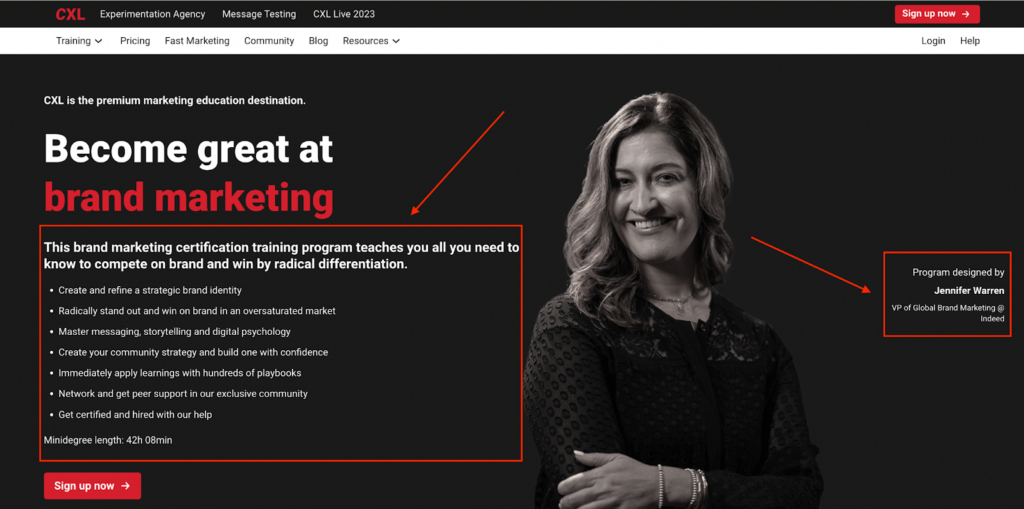
While the black-white-red color palette immediately stands out, what’s more compelling is how the hero section outlines everything you’ll learn if you take the minidegree, and shows you who’ll be teaching the course and why they’re qualified to do so.
The hero section segues into a minimalist section where the sales copy paints a picture of the challenges businesses face to stay top of mind in saturated markets, how important it is to create a stronger brand identity, and how the mini-degree can help. There’s even a trailer that gives you a glimpse into the BTS of how the mini-degree was created.
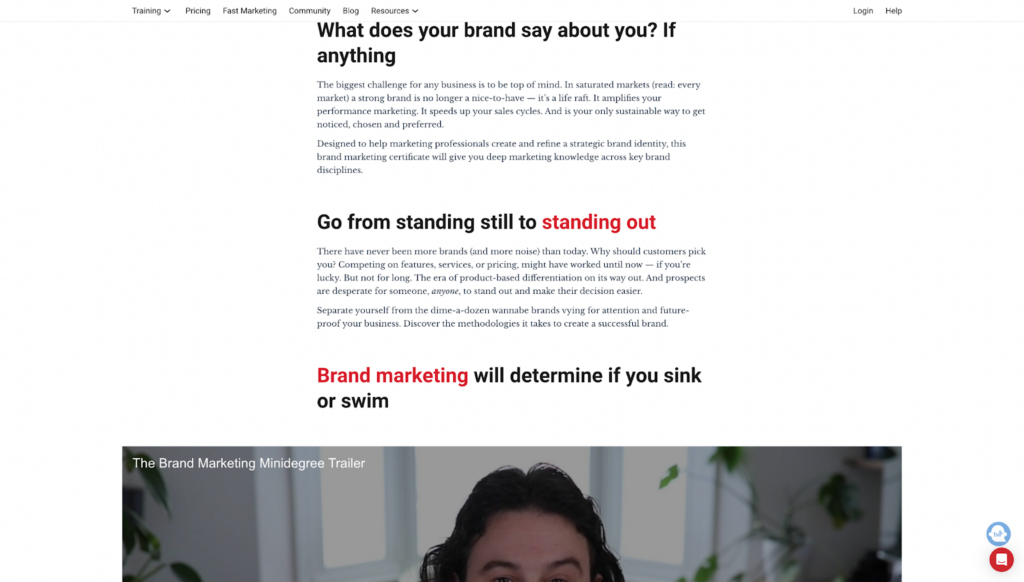
Then, CXL throws in some social proof in the form of reviews from business professionals who’ve taken and benefitted from the mini-degree, followed by a breakdown of the mini-degree’s structure.
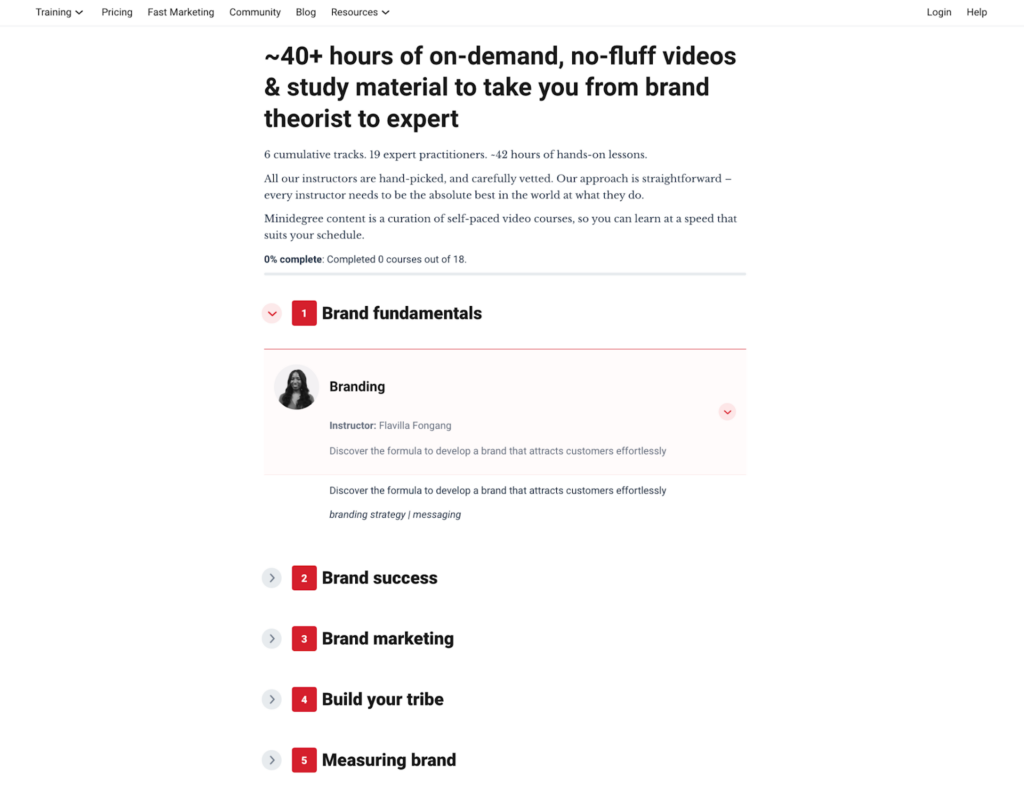
Next, the page outlines the benefits of subscribing to CXL, followed by a form that allows users to see pricing plans and request a demo. The landing page ends with a comprehensive FAQ section that answers the most common questions that prospective customers may have.
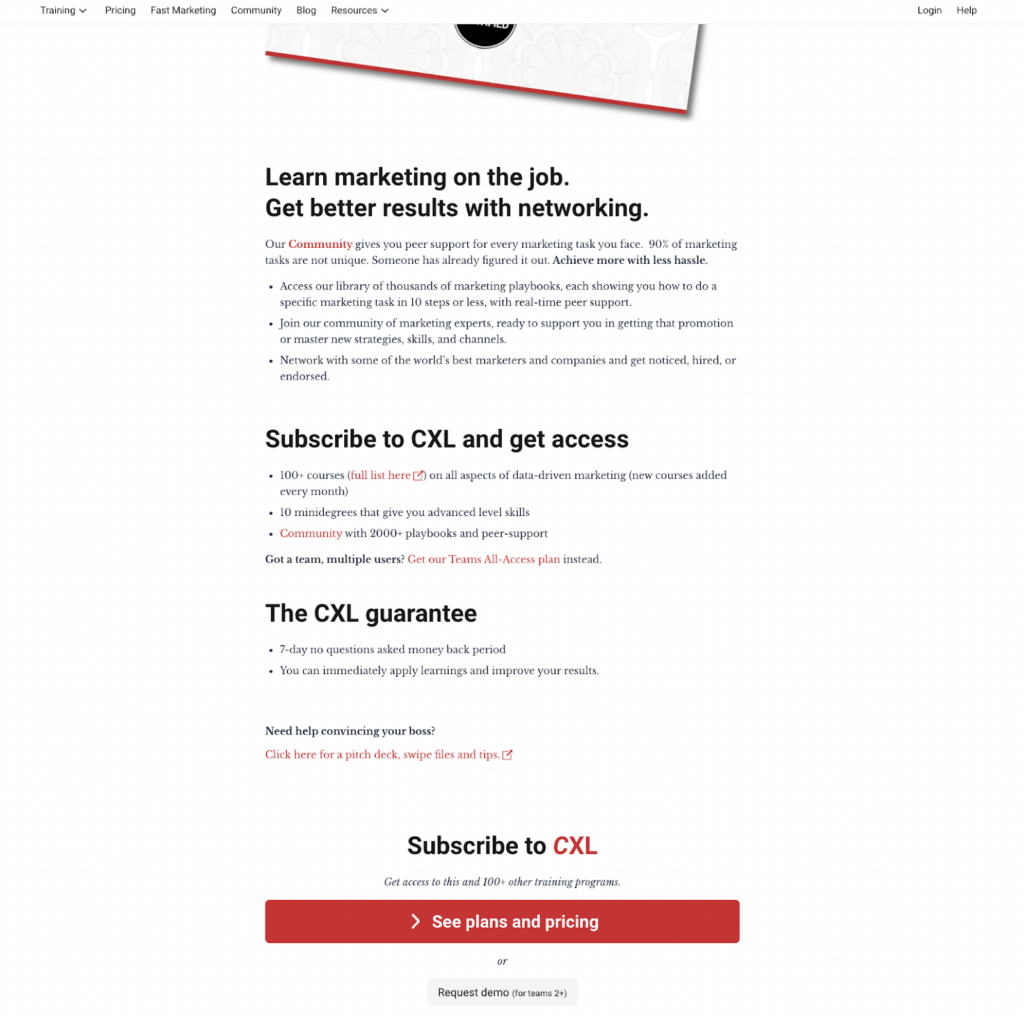
Just like CXL’s landing page, yours should have a form (or CTA) that people have to take action on before they can access your video.
Promote your gated video content
Once your landing page is up and your video is safely gated, it’s time to promote it. There are various marketing channels you can use including:
- Search: While Google’s algorithms can’t crawl gated content, they can crawl the contents of your dedicated landing page and rank it for the right keywords, which will improve its visibility and drive traffic to the page.
- Social media: You can build momentum by posting about your gated video before you create it. Take your audience on the video creation journey and explain the value they’ll get from the final product. This way, when the landing page goes live, there’ll be people ready to sign up.
- Paid advertising: Building momentum through organic SEO and social media marketing can take time. If you want quicker results and you have a budget, run pay-per-click (PPC) ads for the landing page on search engines and social media.
- Email marketing: If you have an email list, take the same approach as with social media. Send promotional emails to prime your subscribers for the launch of your video content. Tell them about the value of the video, and when the landing is up, send occasional emails reminding them to sign up.
As you generate leads through your landing page, nurture them by sending follow-up emails and providing additional value through exclusive offers and related resources (including your products).
Analyze and iterate
Once you start getting email conversions from your gated video content, monitor your performance using analytics tools. Track metrics and key performance indicators (KPIs) like viewer retention, conversion rates, and lead quality.
Use the insights you gather to refine your strategy, whether that’s improving your video creation techniques, adjusting content types, changing distribution channels, or revising your targeting.
Doing SEO for gated video content
Google’s algorithms don’t crawl and index content that’s behind a form. This means that when you gate your video content, it won’t rank on the search engine results pages (SERPs). You can, however, use SEO to boost the visibility of your gated videos by
- Optimizing your dedicated landing page for search engines
- Embedding your lead capture form within ungated, SEO-optimized content like blog posts
- Optimizing the videos themselves
To get the most visibility, you’ll need to implement the three kinds of SEO: on-page SEO, off-page SEO, and technical SEO.
On-page SEO
This involves doing keyword research to identify relevant high-volume, low-competition keywords that your target audience is likely to use when searching for content related to your video.
To optimize your landing page, blog posts, and videos, include these keywords in the title tags, (sub)headings, page copy, image alt texts, meta (and video) descriptions, and URLs, where applicable.
When Google’s algorithms crawl your website, these keywords will give them some context so they can rank your web pages for the right search term/query.
Off-page SEO
Off-page SEO are optimization techniques you implement outside your website to increase its ranking on the SERPs. This includes backlink building, social media marketing, paid advertising, guest posting, public relations (PR), and brand mentions.
Backlinks are arguable the most important aspect of off-page SEO because Google regards them as a core ranking factor. A strong backlink profile fulfills the “T” in E-E-A-T (trustworthiness), which is the framework Google uses to assess the quality of content on a website.
Building backlinks involves getting reputable websites to link to the landing page and/or blog post through which people can sign up for your gated video content. When this happens, Google’s algorithms interpret it to mean that your offer is relevant, valuable, and fulfills search intent.
Technical SEO
Technical SEO involves improving the technical parts of your website to increase your SERP rankings. This includes making your website mobile-friendly, increase your page load speed, adding website/video schema markup, submitting your website/video sitemap to Google, creating an SEO-friendly website structure, and fixing duplicate content.
Not only are some of these techniques (like increasing site speed and making your website responsive on all devices) ranking factors, but they also make it easier for Google to crawl and rank your site.
Pro tip: Make your videos even more accessible to humans and search engines alike by providing accurate transcriptions and closed captions.
Best practices for gated videos
As you create gated videos, here are some best practices to keep in mind:
Keep videos at an optimal length
The amount of time your audience is willing to spend on a video depends on several factors, including where they are in the sales funnel, their state of mind, the content format, etc.
It’s not possible to control all these factors, but there are some you can optimize, including your sales funnel and the content format you use.
For example, prospects in the Awareness stage of your funnel may just be hearing about your brand for the first time, so they’re likely not ready to watch a lengthy video. People in this stage often benefit more from ungated content, such as blog posts and short videos on social media.
However, prospects who are considering your product or trying to weigh your product’s value against your competitor will be more open to attending your expert-led webinars, buying online courses, watching success stories, and booking product demos.
The lengths of these various video content formats differ, too. For example, the videos that make up an online course can be 3 – 20 minutes long, with the entire course lasting a couple of hours. Webinars and exclusive interviews often last 1-2 hours, and case study videos are usually 5-10 minutes long.
Pro tip: Create multiple edits. After your first recording, you’ll end up with a lot of footage. You’ll need to edit it multiple times to get rid of fluff, off-the-tangent commentary, filler words, etc. You’ll also be able to make animations and add other interactive, engaging elements to the video.
Create compelling thumbnails and titles
Your title and thumbnail are the first things people see when they visit your landing page or the blogs in which you embed your gated video. These elements need to grab your visitors’ attention and entice them to sign up for access to the video.
You can create your thumbnail yourself if you have great graphic design skills. If not, it’s best to hire a graphic designer or marketer with design skills to do it for you.
Pro tip: Don’t use clickbait titles. Your title should accurately represent the content in the video. If not, it’ll create a negative user experience, hurting your brand’s credibility and reputation.
Streamline your lead capture form
Many companies only ask people to fill in their name and email address to get access to gated content, while others ask for additional information, including job title, organization size, and industry. Some even ask their visitors to complete a short survey to gain access.
The name-and-email address approach works pretty well because it allows you to send personalized (by name) emails to the subscriber’s inbox. However, if you’re trying to segment your email subscribers based on their industry and job title, you should ask for that information, too. This helps you create content that is tailored specifically to each segment, which, in turn, improves the chances of people engaging with your brand and buying your product.
Pro tip: A lengthy form often turns people away. So if it’s not necessary, take the name-and-email address approach.
Include clear calls-to-action
Calls-to-action tell people what you want them to do after getting access to your resource. With gated video content, you’ll need at least two different CTAs: one on the landing page that directs people to sign up for the video and another in the video that tells people what they should do after watching it.
On your landing page, use persuasive and direct language to prompt action, e.g. “Access expert insights now” and “Download the course now”. In your video, you can prompt viewers to visit your website/social media or subscribe to your YouTube channel, depending on the goal you want to achieve.
Whatever your CTA is, ensure that it’s specific, actionable, and accessible. Place them in strategic places on your landing page and video, especially if those resources are long.
Pro tip: Consider offering incentives, such as discounts, downloadable resources, or access to an exclusive community to sweeten the deal and encourage opt-ins.
Run A/B tests
As you monitor your performance, run A/B tests on different elements of your gated video content strategy, including the title, thumbnails, content formats, messaging, and CTAs. This will give you insights into which variations resonate best with your audience and help you optimize your conversion rates over time.
Gated video platforms
If you’re wondering what tools you can use to create gated videos, here’s a breakdown of four of the best gated video platforms, including their features and pricing.
| Vimeo | Wistia | Brightcove | SproutVideo | |
| Overview | An online video platform known for high-quality video hosting, customization, and playback options | A video hosting and marketing platform designed to help businesses engage their audience through video content | A cloud-based video hosting and publishing platform that caters to a wide range of video needs, from live streaming to on-demand content | A video hosting and marketing platform with a focus on security and customization |
| Features | 4K Ultra videos Video management Privacy controls 360-degree video support Live-streaming capabilities OTT (Over The Top) streaming Password protection Team collaboration tools Integration with Adobe Premier Pro Player customization Video monetization options Lead generation Email marketing integrations Advanced analytics | Player customization Annotation links Ad-free video hosting Video chapters Video links and CTAs A/B testing Wistia Channels Built-in accessibility options Lead generation Live streaming Integration with CRMs and other marketing tools Advanced video analytics | CSS and JavaScript customization Responsive video player Privacy controls Video SEO Video marketing features Video interactivity OTT streaming Integration with popular ads and analytics systems, such as Freewheel and Google Doubleclick | Player customization HD video Live streaming Video management Lead capture tools Content management Video SEO Password protection Geo-restriction IP address restriction Integration with marketing tools like HubSpot and Mailchimp Detailed video analytics |
| Pricing | 7-day free trial Paid plans range from $20/month to $108/month (Save 40% with annual subscription) Custom pricing for businesses | 14-day free trial Paid plans range from $24/month to $399/month (Save 20% with annual subscription) Custom pricing for businesses | Contact sales for custom pricing based on usage and needs | 30-day free trial (no credit card needed) Paid plans range from $10/month to $295/month No custom pricing for businesses |
Choosing the right gated video platform
If you feel stuck on which gated video platform you should use, here are some tips to help you select the best one for your needs and goals:
Define your requirements
Before choosing a video platform, ask yourself what you want the platform to help you accomplish. Your answers will help you choose an appropriate tool for your needs.
For example, if your goal is to generate leads, Vimeo is a great choice because it has lead generation features and integrates seamlessly with email marketing tools. But if your priority is to generate organic traffic through SEO, Brightcove and Sproutvideo might be better choices.
Consider your budget
Video platforms come with varying pricing models and tiers, including subscription-based, pay-per-view, or hybrid options. So evaluate your financial constraints and pick a platform that offers the features you need within your budgetary limits.
The pricing tiers offered by the platform are a great place to start to determine if you can afford it, but you should also factor in potential additional costs such as bandwidth charges or transaction fees, as these can impact the overall affordability of the platform.
Consider customization options
The video platform you choose should give you control over the appearance and functionality of the video player. So look out for features that allow you to customize the branding, player design, and interactive elements like CTA buttons.
Consider integration capabilities
If you’re planning to execute a gated video content strategy, chances are you have many other tools in your tech stack. To streamline your workflow, you’ll need to choose a video platform that integrates seamlessly with your existing tools and systems.
This includes your website, content management system (CMS), customer relationship management (CRM) software, email marketing services, marketing automation platforms, payment gateways, and any other software crucial to your business.
Review privacy and security features
If you’re handling confidential or sensitive information, ensure that the video platform you choose has robust security measures. SproutVideo, in particular, is a great tool for this purpose because it has features like password protection, geo-restriction, IP address restriction, and encryption protocols to protect your data.
Assess analytics and reporting
Comprehensive analytics and reports are crucial for tracking the performance of your gated content and understanding how your audience engages with your brand.
Look out for platforms that offer details viewer insights, such as view duration, click-through rates (CTR), conversion rates, audience demographics, and other relevant KPIs. These insights will help you refine your content strategy and optimize for better engagement.
Check for scalability
If you run or work at a fast-growing company, the video platform you choose should be able to handle increased video uploads and higher traffic volumes without compromising on performance. In other words, the platform should scale with you.
Therefore, consider factors like available storage, bandwidth options, and support for high-definition (HD) video to ensure that the platform is scalable and that your investment will remain relevant as your business evolves.
Product demos and trial periods
Many video platforms offer product demos and/or trial periods, which you can take advantage of to get hands-on experience with the platform. Not only will you be able to assess whether it meets your requirements, but you’ll also learn how to navigate the platform, should you decide to use it.
Measuring the success of your gated video content strategy
To measure the success of your gated video content strategy, there are three things you should do: track key performance indicators (KPIs), use analytics tools, and iterate continuously.
Track key performance indicators
Some common KPIs you should track include:
- Conversion rate: This measures the percentage of viewers who provided their information to access gated content.
- Click-through rate (CTR) on CTAs: This measures how often viewers click on the CTAs in your landing page or videos. This indicates the effectiveness of your CTAs in driving desired actions.
- Engagement metrics: Monitor metrics like average watch time, video completion rates, and video interactions (likes, comments, and shares). This indicates how well your content is resonating with viewers.
- Lead generation: This measures the number of new leads generated through the gated content. It indicates how compelling and persuasive your content is.
- Lead quality: This measures how likely your new leads are to convert into paying customers. You can assess this KPI through lead scoring or qualification criteria.
Use analytics tools
Analytics tools retrieve and organize data from different sources to help you gain more understanding of your overall operations. Some common analytics tools you can use include:
- Google Analytics (GA): This platform assesses user behavior on your site, tracks the performance of landing pages, and monitors traffic sources, among other things. With GA, you can set up goals and events to specifically measure interactions related to your gated content.
- Video hosting platforms: Platforms like Vimeo, Wistia, or YouTube provide detailed insights into video performance. When integrated with lead capture forms, these platforms can track metrics like play rate, engagement, and conversion rates.
- Marketing automation platforms: Tools like HubSpot, Marketo, or Pardot offer analytics tools that allow you to track lead behavior after they engage with your gated content.
- CRM systems: CRM tools like Pipedrive and Salesforce can help you track leads generated from gated video content and monitor their progression through the sales funnel.
Continuous optimization and iteration
Set up regular reporting intervals to monitor the performance of your gated video content strategy. Then, compare data over time (including data generated from A/B tests) to identify trends and patterns.
Use the insights you gather from your analytics to make informed adjustments to your strategy, whether that be optimizing your lead capture forms, using different video content formats, or switching distribution channels.
Transform your business with gated video content
Embracing gated video content is an excellent way to supercharge your marketing strategy. By offering valuable content in exchange for user information, you’re not only capturing leads but also creating a direct line of communication with an engaged audience. This allows you to deliver personalized messages and nurture potential customers through the buyer’s journey.
Your gated video content also helps you showcase your expertise, position your brand as a trusted authority, and build a sense of exclusivity and value for your audience — which ultimately drives brand advocacy and conversions.
If you need a scalable platform to handle your video content marketing, look no further than Thinkific Plus. Thinkific Plus is a learning management system with enterprise-grade features that allows you to create, market, and sell educational video content to your customers. There are video editing, distribution, and payments tools you can leverage to make sure your webinars, video courses, onboarding videos, and other downloadables reach as many people as possible.
Thinkific Plus also allows you to build and manage exclusive communities, which helps you foster a deeper connection with your prospects, upsell your products, drive conversions, and generate revenue for your business.
Book a call with a Thinkific expert today.
FAQ
What is gated video content and why is it important?
Gated video content refers to videos that are accessible only after viewers provide personal information, such as their email address or demographic details. This marketing tactic allows businesses to capture and nurture high-quality leads through personalized emails and targeted marketing efforts.
What are the benefits of using gated videos in marketing?
Using gated videos in marketing allows businesses to capture leads, gather valuable customer data, and deliver personalized content, which fosters trust with their audience and leads to increased conversions.
How can I create an effective gated video strategy?
Here is a step-by-step breakdown of developing a successful gated video content strategy:
- Define your goals
- Identify your target audience
- Pick the right content video and types (e.g. webinars, video courses, product demos, etc.)
- Create compelling videos
- Create a dedicated landing page
- Promote your gated video content
- Analyze and iterate based on insights gathered
What are some best practices for creating engaging gated videos?
As you create gated videos, here are some best practices to keep in mind:
- Keep videos at an optimal length
- Create compelling thumbnails and titles
- Streamline your lead capture form
- Include clear calls-to-action
- Run A/B tests to improve your strategy
Which gated video platforms are best for my business?
Some popular platforms you can use to create gated videos that resonate with your audience include:
- Vimeo: Known for extensive customization options and high-quality video playback.
- Wistia: Offers customizable video players, email capture forms, and detailed analytics.
- Brightcove: Comprehensive platform with robust features for large enterprises and media companies.
- SproutVideo: Video hosting platform with a strong emphasis on security, with features like domain restrictions and password protection.
How do I measure the success of my gated video content strategy?
There are two ways to track and analyze the performance of your gated videos:
- Tracking key performance indicators (KPIs), including conversion rate, click-through rate (CTR), and engagement metrics (likes, shares, and comments)
- Using analytics tools, such as Google Analytics, video hosting platforms, CRM tools, and marketing automation tools
- Compare KPIs to industry averages for more context on your performance
Want to learn more about video? Learn how to improve your video quality without reshooting here.


